Prediction and Analysis of Multi-Response Characteristics on Plasma Arc Cutting of Monel 400™ Alloy Using Mamdani-Fuzzy Logic System and Sensitivity Analysis
Abstract
:1. Introduction
2. Methodology
2.1. Response Surface Methodology
2.2. Fuzzy Logic Expert System
3. Experimental Details
4. Results and Discussion
4.1. Regression Modeling and Statistical Analysis
4.2. Fuzzy Modeling of PAC Process Parameters
4.3. Assessment of Fuzzy and Response Surface Models
4.4. Sensitivity Analysis
5. Conclusions
- The ANOVA table reveals that the developed quadratic models for MRR, KT, and HAZ are found to be adequate with an experimental result within 95% of assurance level to envisage the responses precisely within the boundaries of considered PAC variables.
- Experimental results showed that MRR improves with an increase in the arc current and stand-off distance, whereas it significantly decreases with an increase in the cutting speed and gas pressure. KT is found to be minimal when all the selected parameters are kept at a lower level. The combination of higher cutting speed and lower arc current with intermediate values of gas pressure and stand-off distance produced lower HAZ.
- Morphological examination of cut surfaces reveals that, the presence of striation lines, dross formation, and micro cracks significantly affected the surface quality.
- The average prediction error between the fuzzy and experimental values are 0.04% for MRR, 0.48% for KT, and 0.46 for HAZ, whereas the average error observed between regression models and experimental results are 0.51%, 0.51%, and 0.68% for MRR, KT, and HAZ, respectively. It is evident that the fuzzy logic expert system is found to be superior in predicting the responses in PAC of the Monel 400 alloy.
- The sensitivity analysis results suggested that the stand-off distance (+12 to −25) is the most sensitive parameter to MRR. The gas pressure (+7 to −8) and stand-off distance (+7 to −5) are more sensitive to KT, whereas the stand-off distance (−123) is a highly sensitive parameter to HAZ.
Author Contributions
Funding
Conflicts of Interest
References
- Rao, R.; Yadava, V. Multi-objective optimization of Nd: YAG laser cutting of thin superalloy sheet using grey relational analysis with entropy measurement. Opt. Laser Technol. 2009, 41, 922–930. [Google Scholar] [CrossRef]
- Dubey, A.K.; Yadava, V. Multi-objective optimization of Nd: YAG laser cutting of nickel-based superalloy sheet using orthogonal array with principal component analysis. Opt. Lasers Eng. 2008, 46, 124–132. [Google Scholar] [CrossRef]
- Thakur, A.; Gangopadhyay, S. Dry machining of nickel-based super alloy as a sustainable alternative using TiN/TiAlN coated tool. J. Clean. Prod. 2016, 129, 256–268. [Google Scholar] [CrossRef]
- Tamilarasan, A.; Rajamani, D. Multi-response optimization of Nd: YAG laser cutting parameters of Ti-6Al-4V superalloy sheet. J. Mech. Sci. Technol. 2017, 31, 813–821. [Google Scholar] [CrossRef]
- Nair, A.; Kumanan, S. Optimization of size and form characteristics using multi-objective grey analysis in abrasive water jet drilling of Inconel 617. J. Braz. Soc. Mech. Sci. Eng. 2018, 40, 121. [Google Scholar] [CrossRef]
- Shabgard, M.R.; Farzaneh, S.; Gholipoor, A. Investigation of the surface integrity characteristics in wire electrical discharge machining of Inconel 617. J. Braz. Soc. Mech. Sci. Eng. 2016, 39, 857–864. [Google Scholar] [CrossRef]
- Singh, R.; Khamba, J.S. Macromodel for Ultrasonic Machining of Titanium and its Alloys: Designed Experiments. Proc. Inst. Mech. Eng. Part B J. Eng. Manuf. 2007, 221, 221–229. [Google Scholar] [CrossRef]
- Adalarasan, R.; Santhanakumar, M.; Rajmohan, M. Application of Grey Taguchi-based response surface methodology (GT-RSM) for optimizing the plasma arc cutting parameters of 304L stainless steel. Int. J. Adv. Manuf. Technol. 2015, 78, 1161–1170. [Google Scholar] [CrossRef]
- Ramakrishnan, H.; Balasundaram, R.; Ganesh, N.; Karthikeyan, N. Experimental investigation of cut quality characteristics on SS321 using plasma arc cutting. J. Braz. Soc. Mech. Sci. Eng. 2018, 40, 60. [Google Scholar] [CrossRef]
- Salonitis, K.; Vatousianos, S. Experimental Investigation of the Plasma Arc Cutting Process. Procedia CIRP 2012, 3, 287–292. [Google Scholar] [CrossRef] [Green Version]
- Çelik, Y.H. Investigating the Effects of Cutting Parameters on Materials Cut in CNC Plasma. Mater. Manuf. Process. 2013, 28, 1053–1060. [Google Scholar] [CrossRef]
- Abdulnaseer, B.; Bhuvanesh, R. Plasma arc cutting optimization parameters for aluminum alloy with two thickness by using Taguchi method. AIP Conf. Proc. 2016, 060002. [Google Scholar] [CrossRef]
- Chamarthi, S.; Sinivasa Reddy, N.; Manoj Kumar, E.; Ramana Reddy, D.V. Investigation analysis of plasma arc cutting parameters on the unevenness surface of Hardox-400 material. Procedia Eng. 2013, 64, 854–861. [Google Scholar] [CrossRef] [Green Version]
- Maity, K.P.; Dilip Kumar, B. Effect of process parameters on cut quality of stainless steel of plasma arc cutting using hybrid approach. Int. J. Adv. Manuf. Technol. 2015, 78, 161–175. [Google Scholar] [CrossRef]
- Gariboldi, E.; Previtali, B. High tolerance plasma arc cutting of commercially pure titanium. J. Mater. Process. Technol. 2005, 160, 77–89. [Google Scholar] [CrossRef]
- Rajamani, D.; Ananthakumar, K.; Balasubramanian, E.; Davim, J.P. Experimental investigation and optimization of PAC parameters on Monel 400™ superalloy. Mater. Manuf. Process. 2018, 33, 1864–1873. [Google Scholar] [CrossRef]
- Ananthakumar, K.; Rajamani, D.; Balasubramanian, E.; Davim, J.P. Measurement and optimization of multi-response characteristics in plasma arc cutting of Monel 400™ using RSM and TOPSIS. Measurement 2019, 135, 725–737. [Google Scholar] [CrossRef]
- Shabgard, M.R.; Badamchizadeh, M.A.; Ranjbary, G.; Amini, K. Fuzzy approach to select machining parameters in electrical discharge machining (EDM) and ultrasonic-assisted EDM processes. J. Manuf. Syst. 2013, 32, 32–39. [Google Scholar] [CrossRef]
- Rahul; Abhishek, K.; Datta, S.; Biswal, B.B.; Mahapatra, S.S. Machining performance optimization for electro-discharge machining of Inconel 601, 625, 718 and 825: An integrated optimization route combining satisfaction function, fuzzy inference system and Taguchi approach. J. Braz. Soc. Mech. Sci. Eng. 2016, 39, 3499–3527. [Google Scholar] [CrossRef]
- Kuriachen, B.; Somashekhar, K.P.; Mathew, J. Multiresponse optimization of micro-wire electrical discharge machining process. Int. J. Adv. Manuf. Technol. 2014, 76, 91–104. [Google Scholar] [CrossRef]
- Hossain, A.; Nukman, Y.; Hassan, M.A. A fuzzy logic-based prediction model for kerf width in laser beam machining. Mater. Manuf. Process. 2016, 31, 679–684. [Google Scholar] [CrossRef]
- Choudhuri, B.; Sen, R.; Ghosh, S.K.; Saha, S.C. Modelling and multi-response optimization of wire electric discharge machining parameters using response surface methodology and grey–fuzzy algorithm. Proc. Inst. Mech. Eng. Part B J. Eng. Manuf. 2015, 231, 1760–1774. [Google Scholar] [CrossRef]
- Prabhu, S.; Uma, M.; Vinayagam, B.K. Electrical discharge machining parameters optimization using response surface methodology and fuzzy logic modeling. J. Braz. Soc. Mech. Sci. Eng. 2013, 36, 637–652. [Google Scholar] [CrossRef]
- Patel, P.; Nakum, B.; Abhishek, K.; Kumar, V.R. Machining performance optimization during plasma arc cutting of AISI D2 steel: Application of FIS, nonlinear regression and JAYA optimization algorithm. J. Braz. Soc. Mech. Sci. Eng. 2018, 40, 240. [Google Scholar] [CrossRef]
- Özek, C.; Çaydaş, U.; Ünal, E. A Fuzzy Model for Predicting Surface Roughness in Plasma Arc Cutting of AISI 4140 Steel. Mater. Manuf. Process. 2012, 27, 95–102. [Google Scholar] [CrossRef]
- Mohal, S.; Kumar, H. Parametric optimization of multi-walled carbon nanotube-assisted electric discharge machining of Al-10%SiCp metal matrix composite by response surface methodology. Mater. Manuf. Process. 2017, 32, 263–273. [Google Scholar] [CrossRef]
- Rajamani, D.; Balasubramanian, E.; Arunkumar, P. A study on dimensional accuracy of selective inhibition sintered HDPE parts using fuzzy logic. Mater. Today: Proc. 2018, 5, 3817–3824. [Google Scholar] [CrossRef]
- Rajamani, D.; Tamilarasan, A. Fuzzy and Regression Modeling for Nd: YAG Laser Cutting of Ti-6Al-4V Superalloy Sheet. J. Manuf. Sci. Prod. 2016, 16, 153–162. [Google Scholar] [CrossRef]
- Kovač, P.; Rodic, D.; Pucovský, V.; Savkovic, B.; Gostimirović, M. Application of fuzzy logic and regression analysis for modeling surface roughness in face milliing. J. Intell. Manuf. 2012, 24, 755–762. [Google Scholar] [CrossRef]
- Latha, B.; Senthilkumar, V.S. Fuzzy rule-based modeling of drilling parameters for delamination in drilling GFRP composites. J. Reinf. Plast. Compos. 2009, 28, 951–964. [Google Scholar] [CrossRef]
- Bini, R.; Colosimo, B.M.; Kutlu, A.E.; Monno, M. Experimental study of the features of the kerf generated by a 200 A high tolerance plasma arc cutting system. J. Mater. Process. Technol. 2008, 196, 345–355. [Google Scholar] [CrossRef]
- Iosub, A.; Nagit, G.; Negoescu, F. Plasma cutting of composite materials. Int. J. Mater. Form. 2008, 1, 1347–1350. [Google Scholar] [CrossRef]
- Kim, I.S.; Son, K.J.; Yang, Y.; Yaragada, P.K.D.V. Sensitivity analysis for process parameters in GMA welding processes using a factorial design method. Int. J. Mach. Tools Manuf. 2003, 43, 763–769. [Google Scholar] [CrossRef]
- Lakshminarayanan, A.K.; Balasubramanian, V. Comparison of RSM with ANN in predicting tensile strength of friction stir welded AA7039 aluminium alloy joints. Trans. Nonferrous Met. Soc. China 2009, 19, 9–18. [Google Scholar] [CrossRef]
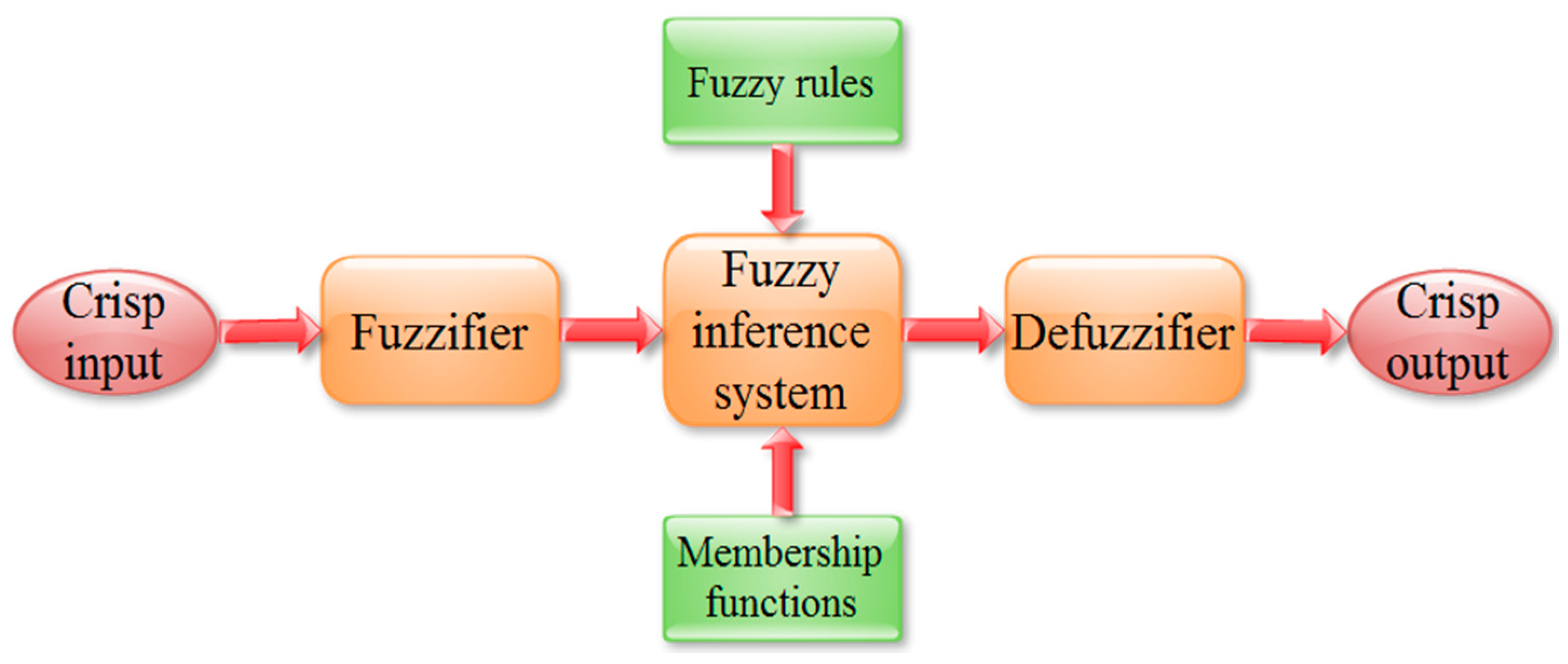
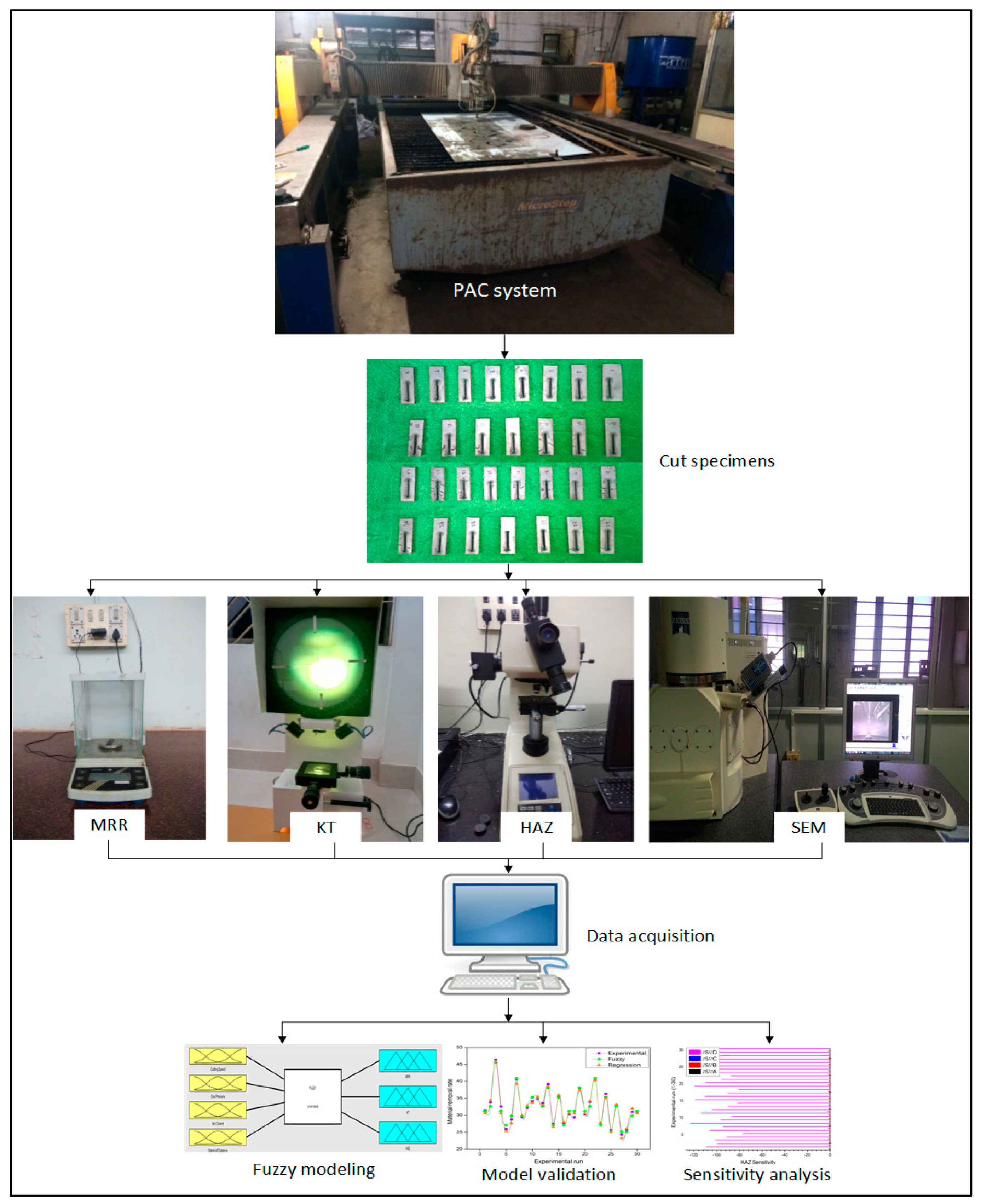

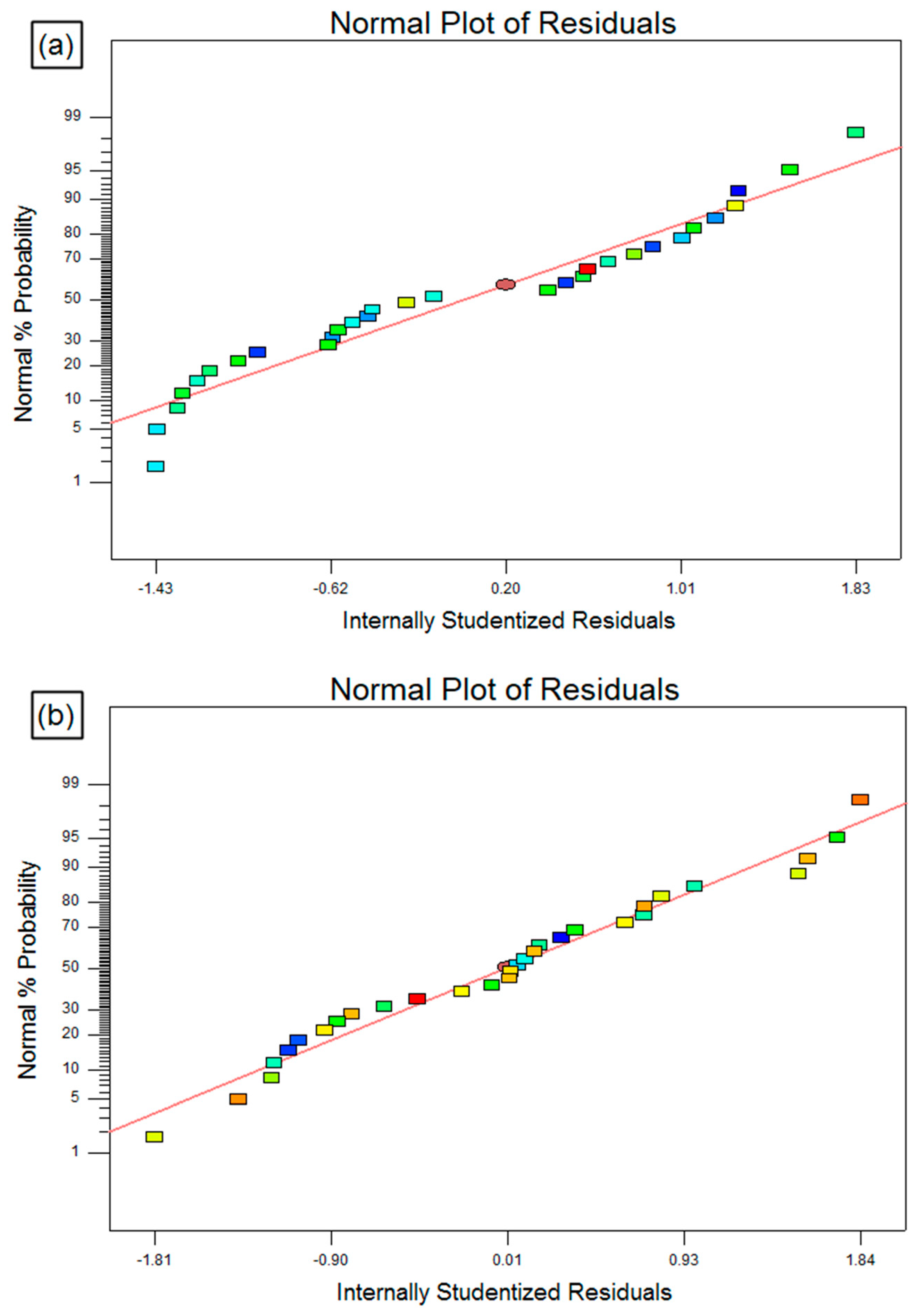


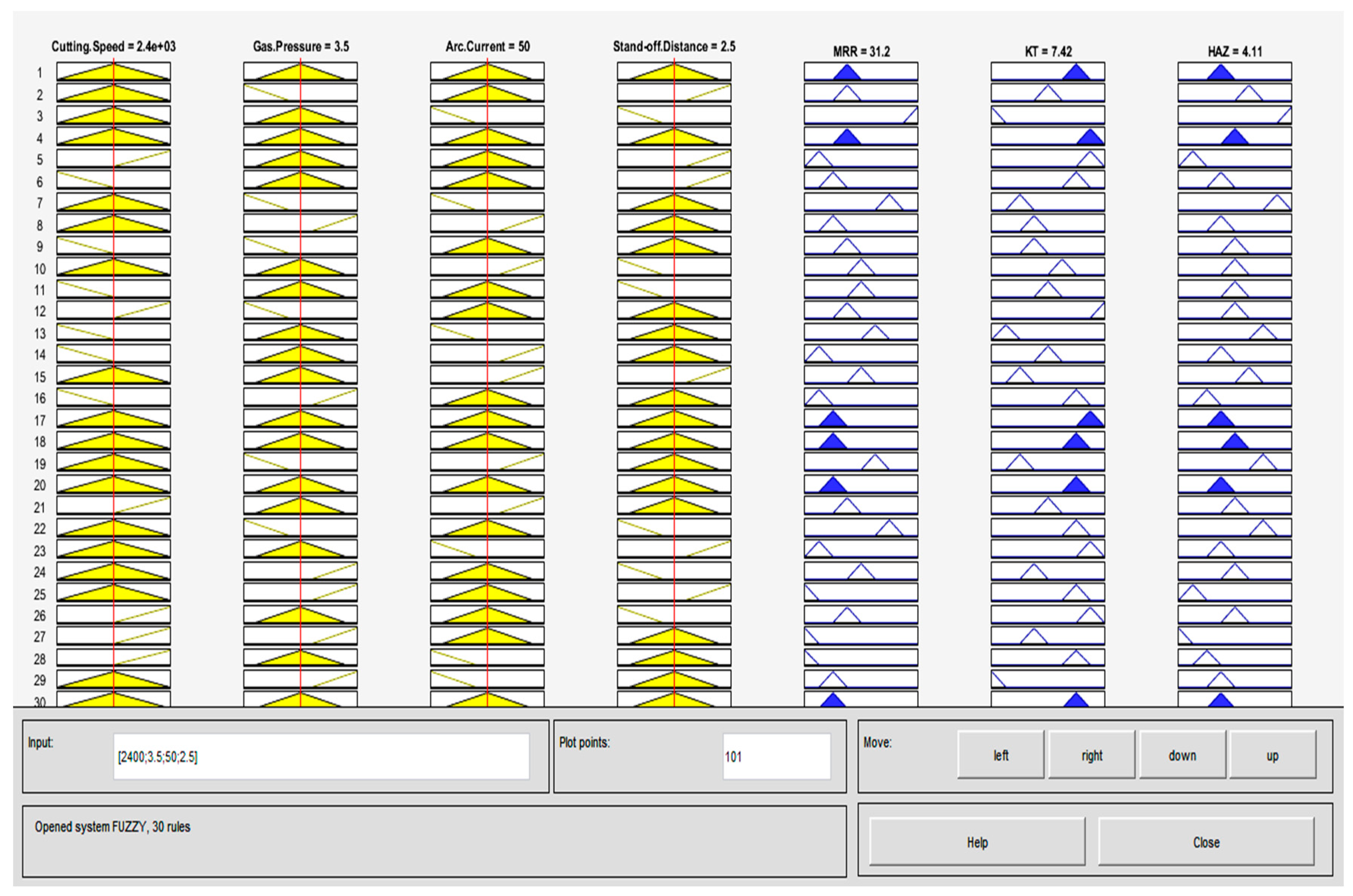
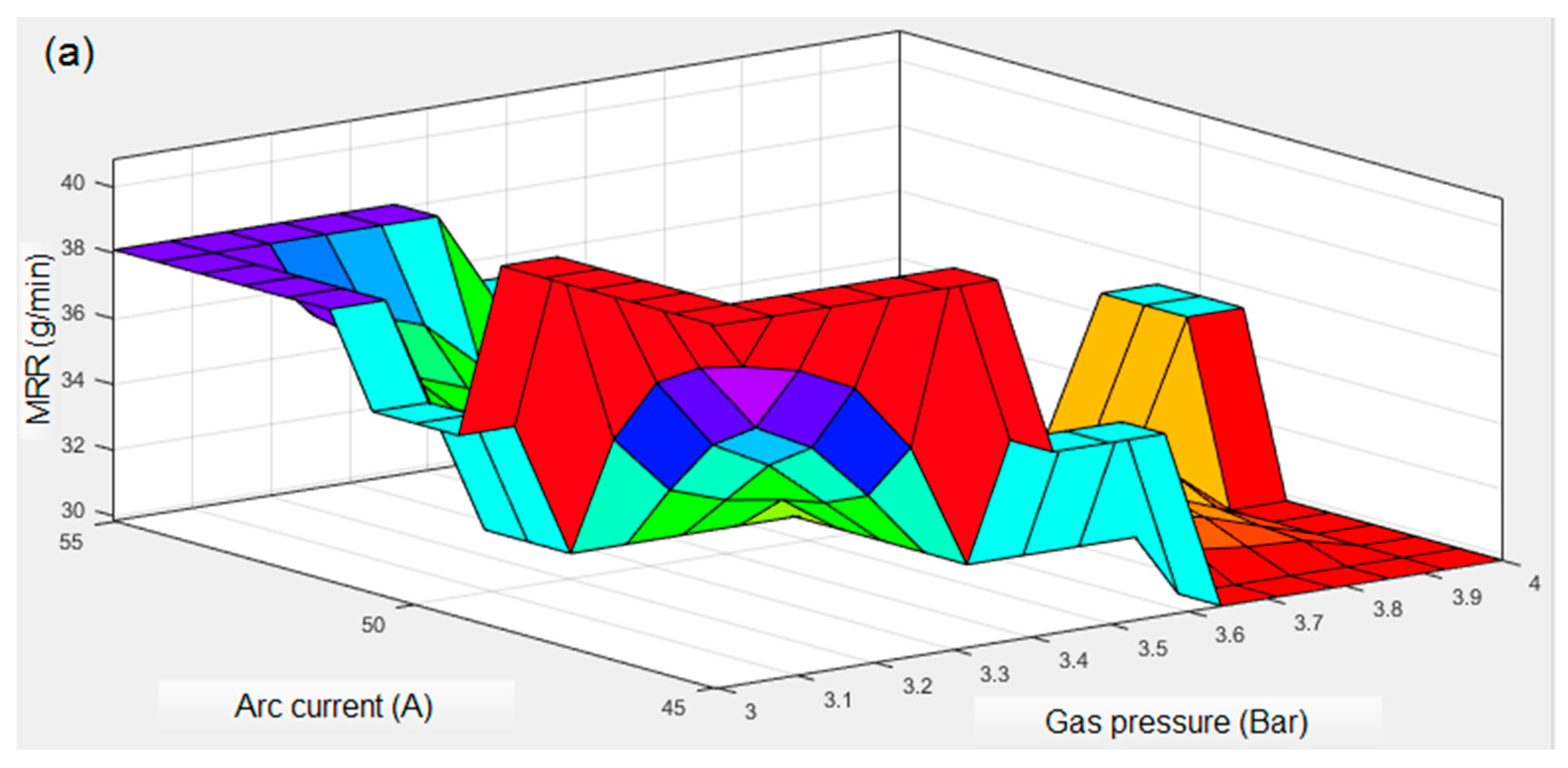
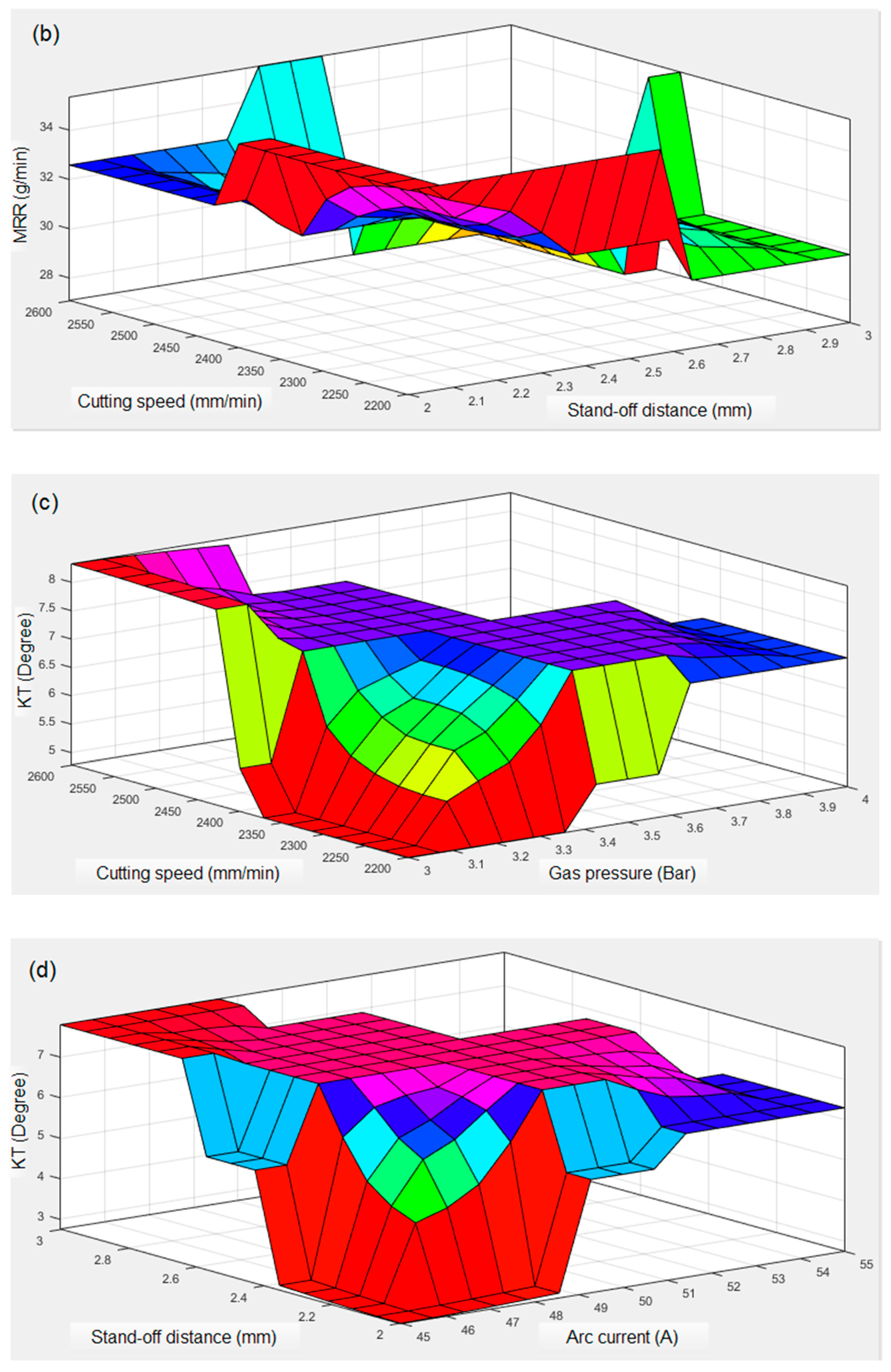
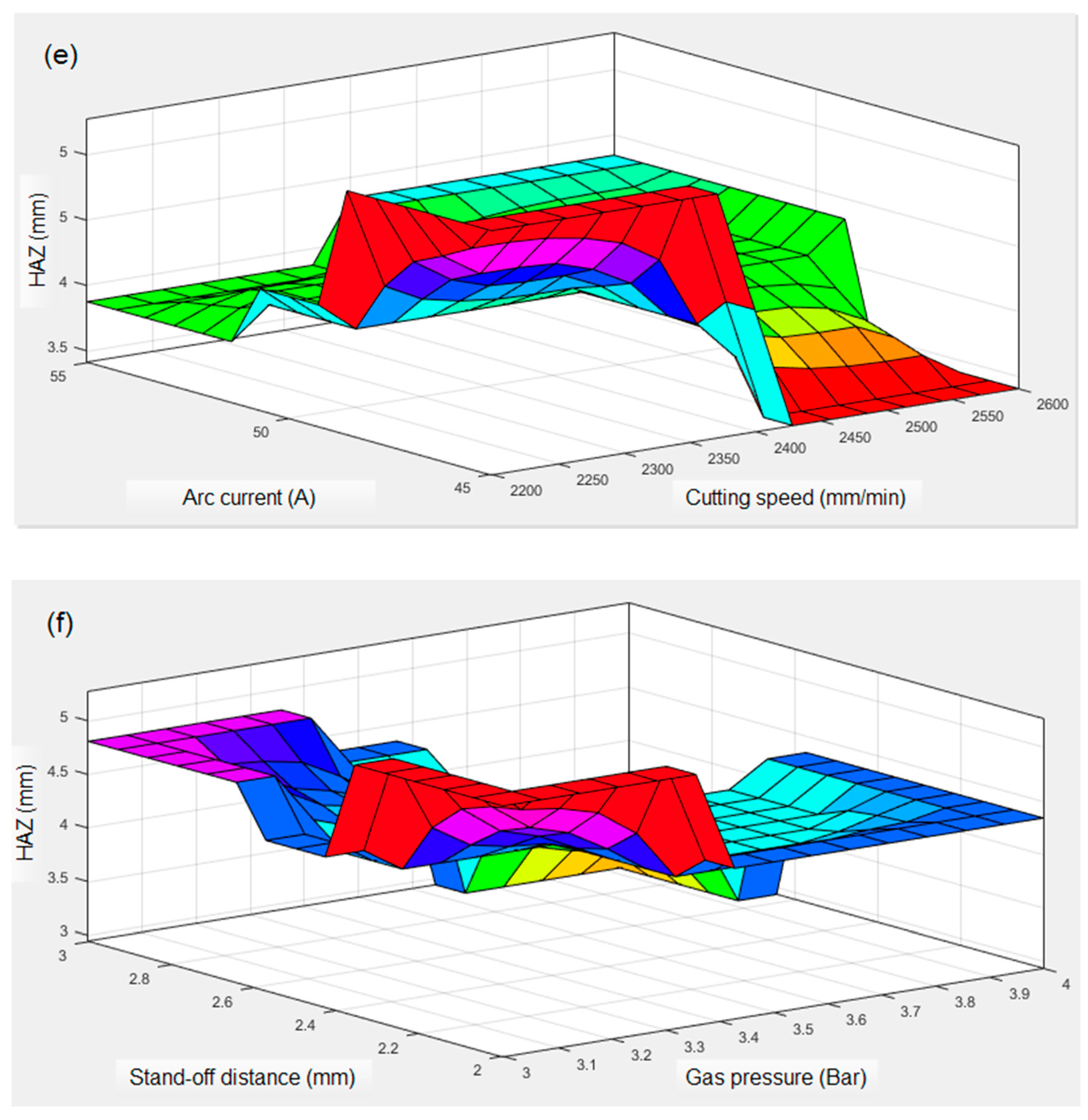

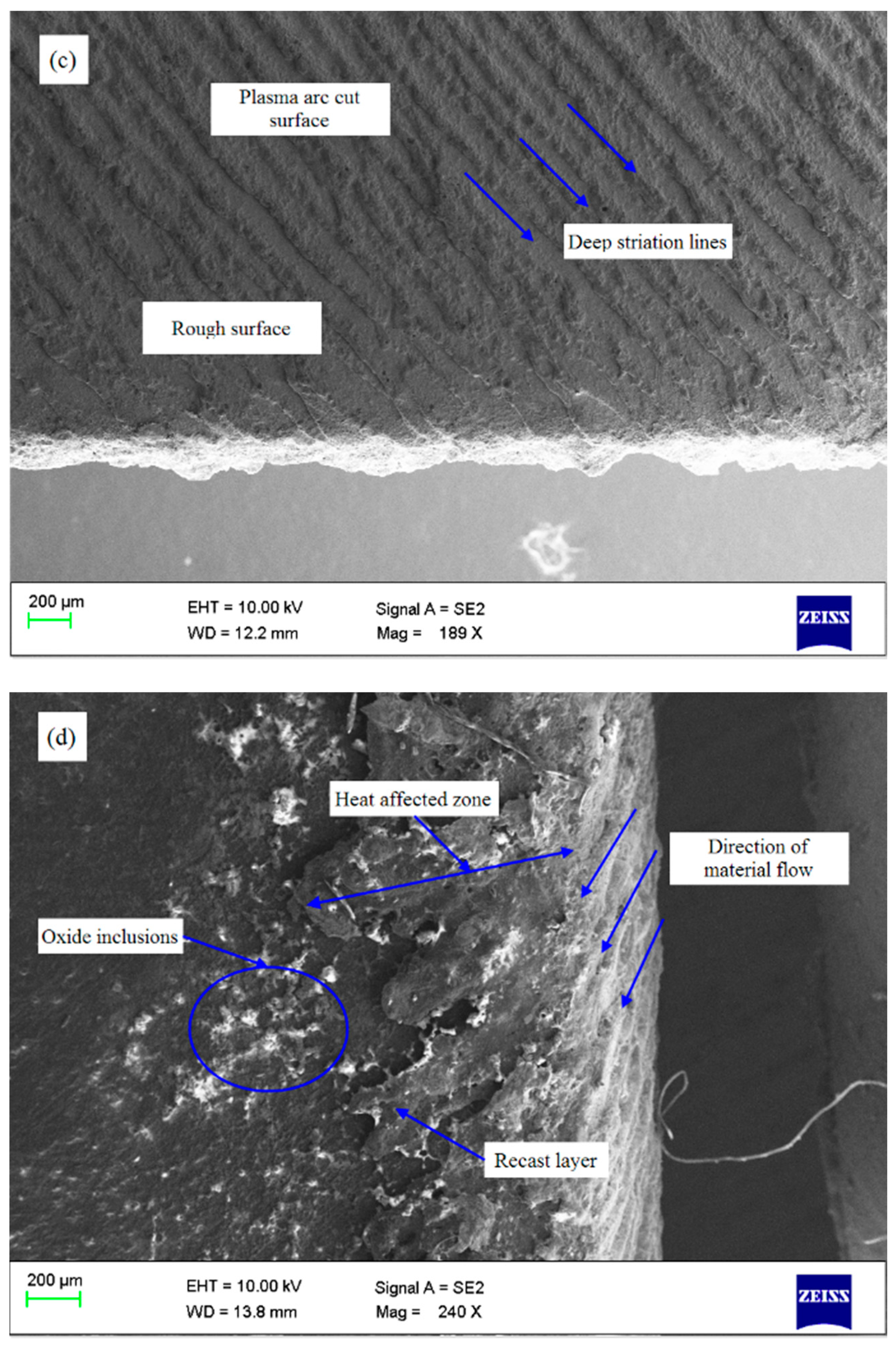

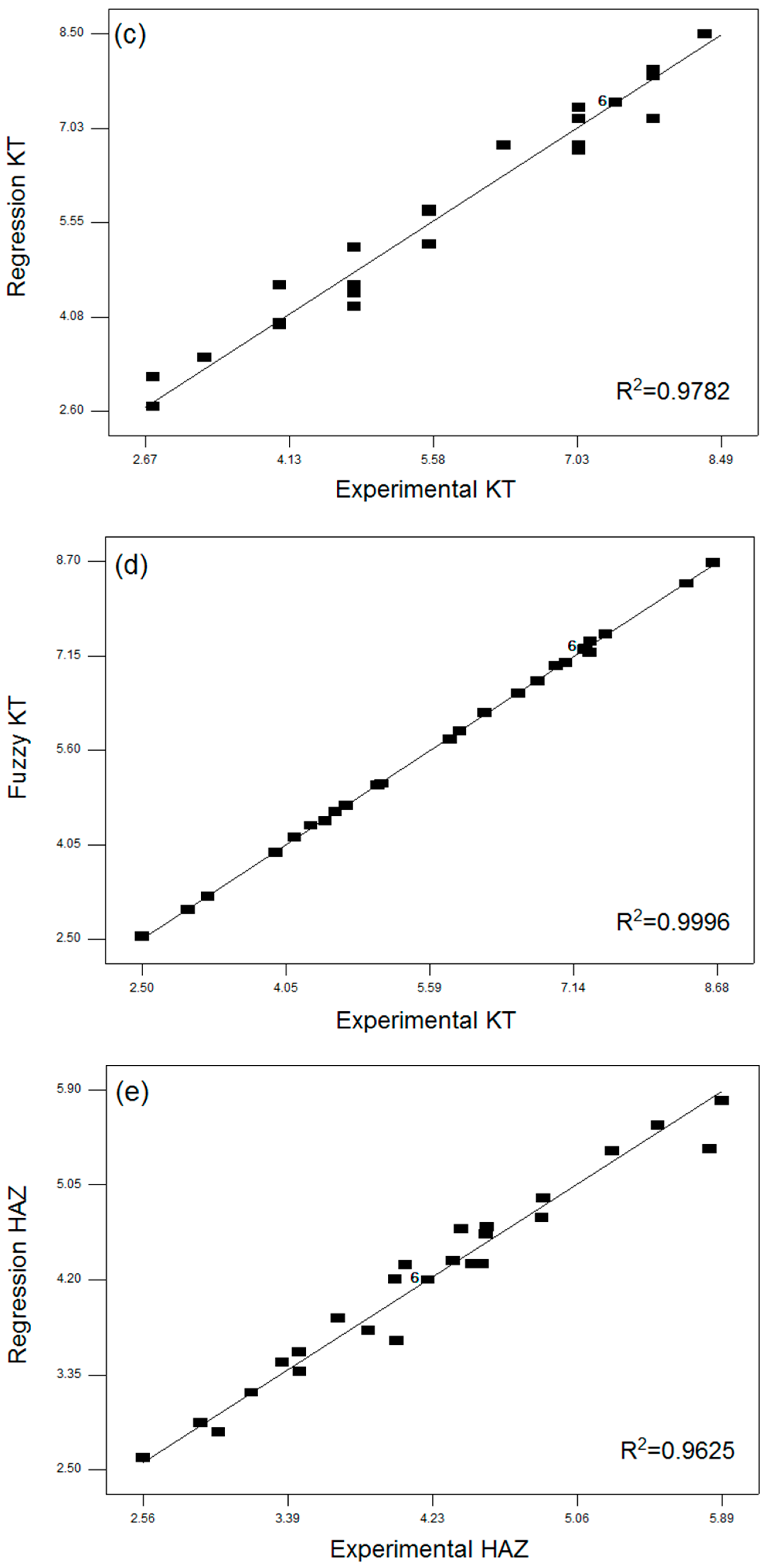

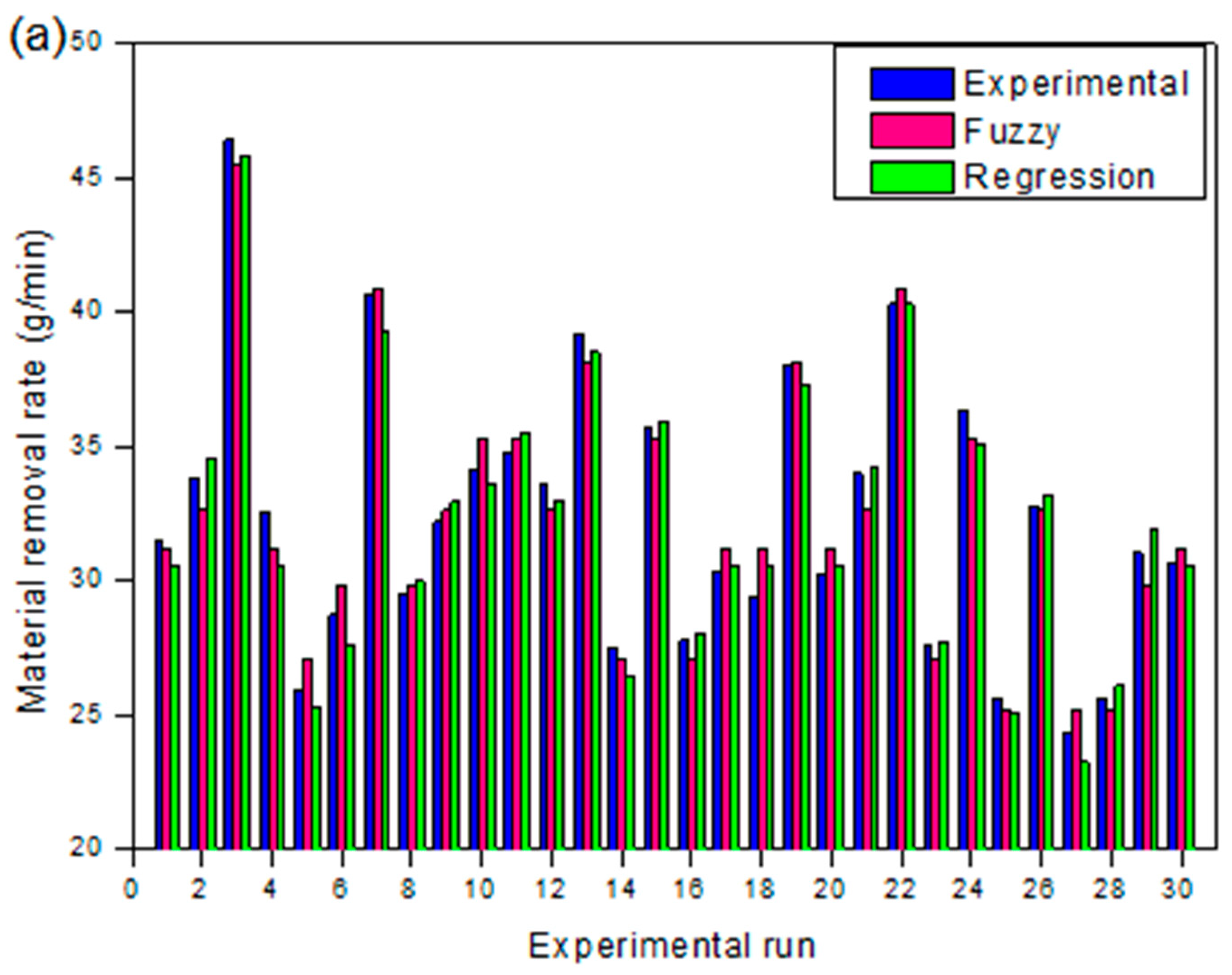
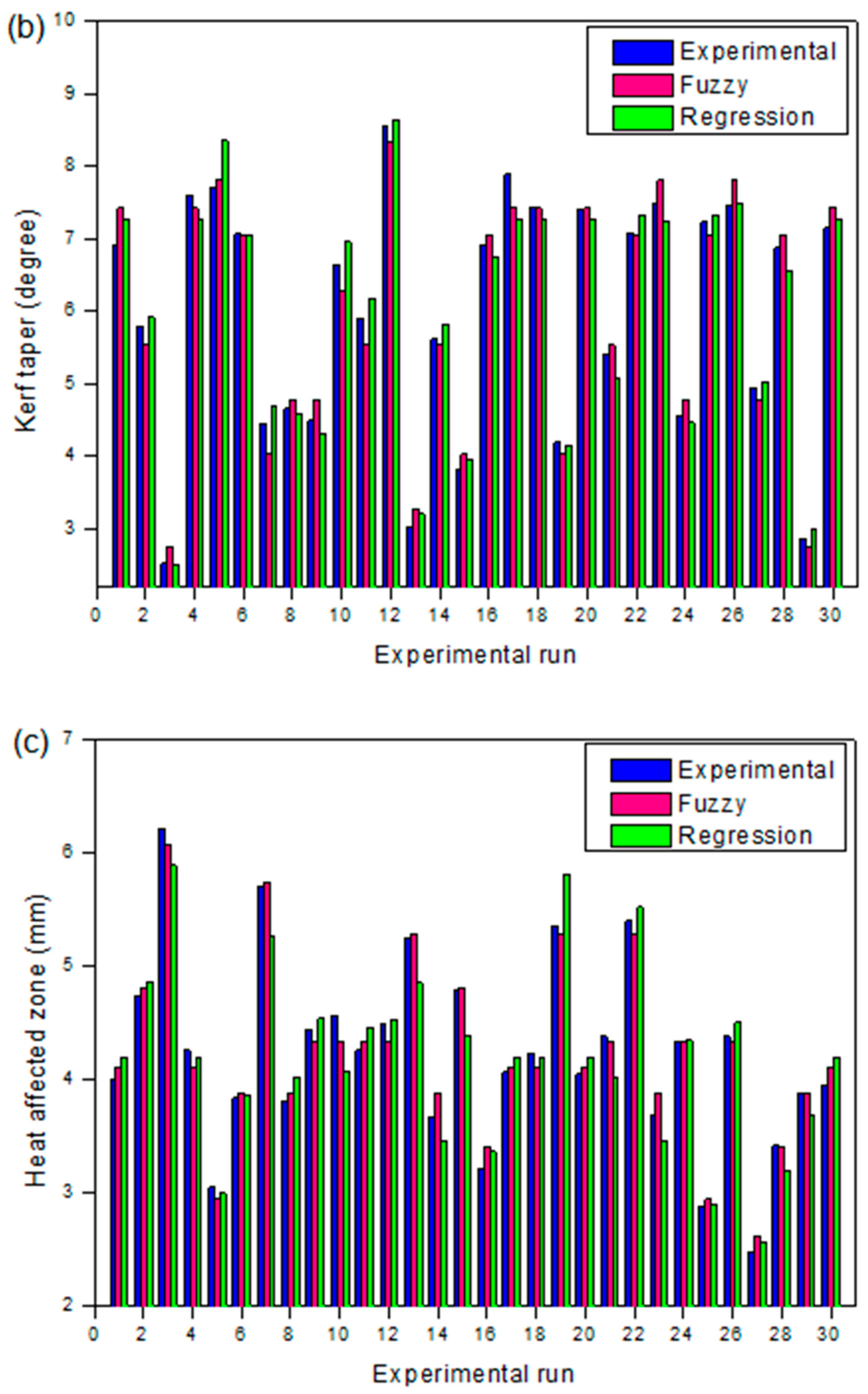

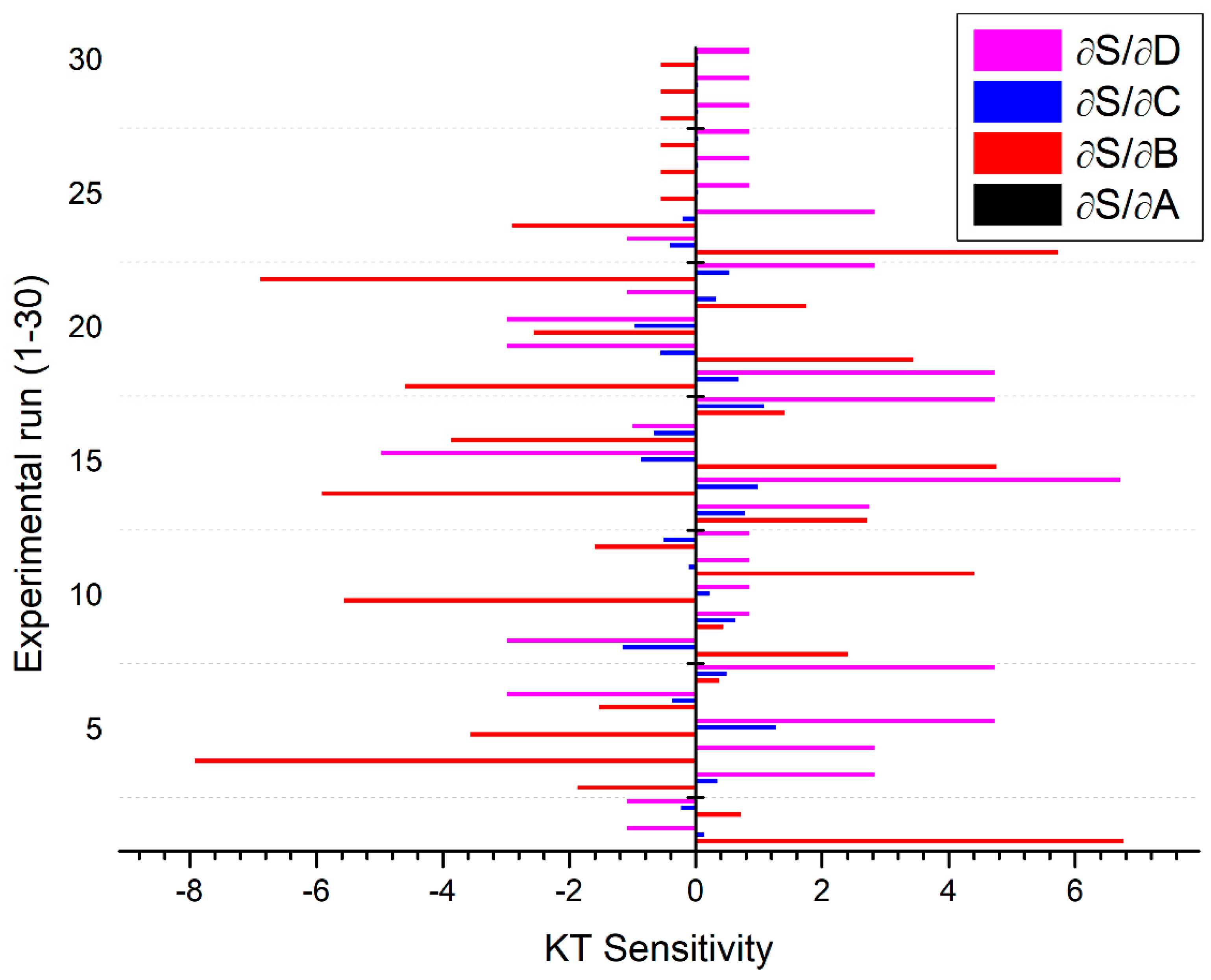
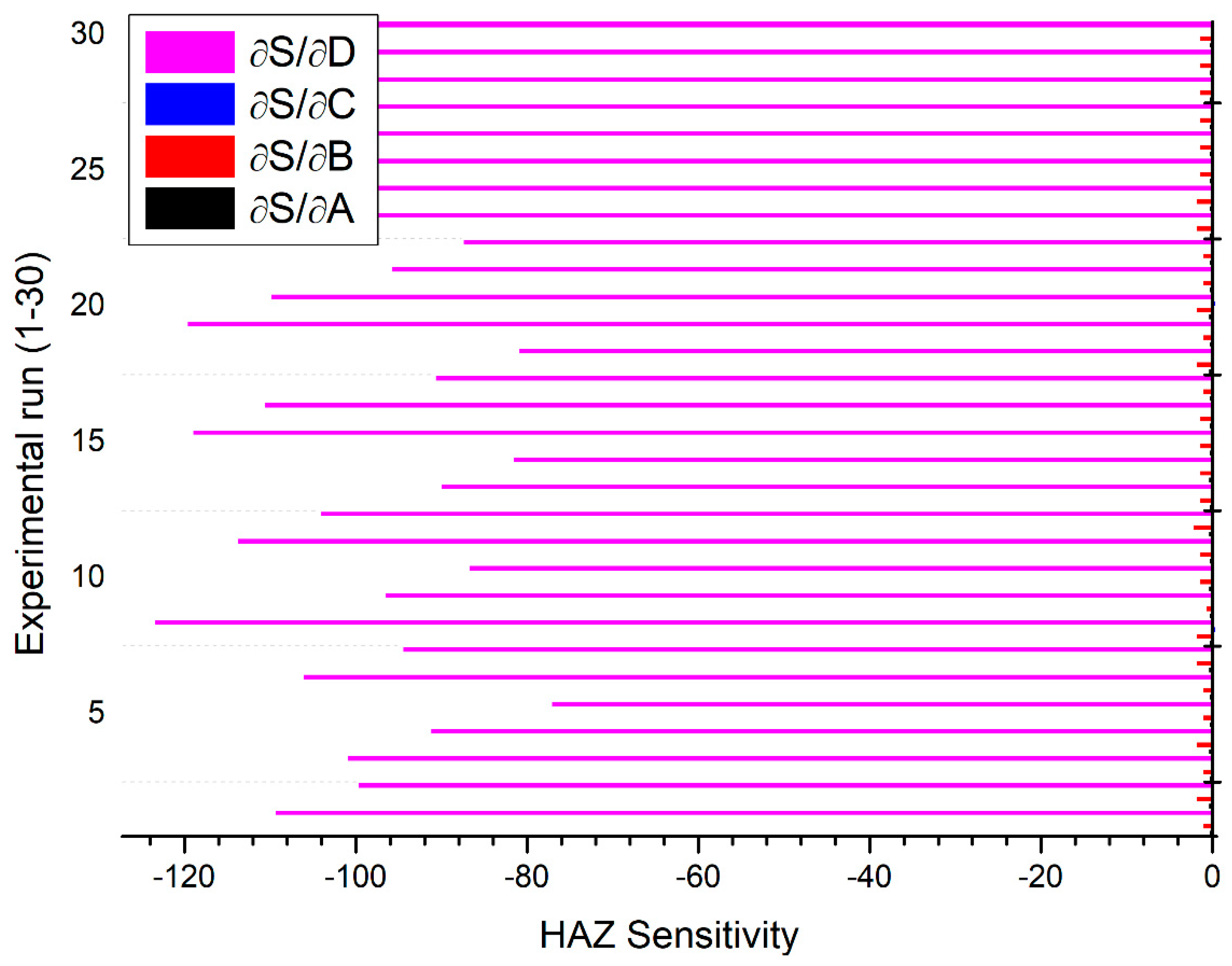
| S. No. | Process Variables | Levels | Unit | ||
|---|---|---|---|---|---|
| Low | Medium | High | |||
| 1 | Cutting speed (A) | 2200 | 2400 | 2600 | mm min−1 |
| 2 | Gas pressure (B) | 3 | 3.5 | 4 | Bar |
| 3 | Arc current (C) | 45 | 50 | 55 | A |
| 4 | Stand-off distance (D) | 2 | 2.5 | 3 | mm |
| Run | Input Parameters | Responses | |||||
|---|---|---|---|---|---|---|---|
| Cutting Speed (mm min−1) | Gas Pressure (Bar) | Arc Current (A) | Stand-off Distance (mm) | MRR (g min−1) | KT (Degree) | HAZ (mm) | |
| 1 | 2200 | 3 | 50 | 2.5 | 32.183 | 4.491 | 4.44 |
| 2 | 2600 | 3 | 50 | 2.5 | 33.57 | 8.557 | 4.5 |
| 3 | 2200 | 4 | 50 | 2.5 | 27.753 | 6.912 | 3.21 |
| 4 | 2600 | 4 | 50 | 2.5 | 24.319 | 4.935 | 2.475 |
| 5 | 2400 | 3.5 | 45 | 2 | 46.371 | 2.52 | 6.21 |
| 6 | 2400 | 3.5 | 55 | 2 | 34.107 | 6.632 | 4.56 |
| 7 | 2400 | 3.5 | 45 | 3 | 27.572 | 7.472 | 3.69 |
| 8 | 2400 | 3.5 | 55 | 3 | 35.718 | 3.815 | 4.785 |
| 9 | 2200 | 3.5 | 50 | 2 | 34.779 | 5.897 | 4.26 |
| 10 | 2600 | 3.5 | 50 | 2 | 32.764 | 7.455 | 4.38 |
| 11 | 2200 | 3.5 | 50 | 3 | 28.736 | 7.07 | 3.84 |
| 12 | 2600 | 3.5 | 50 | 3 | 25.899 | 7.707 | 3.045 |
| 13 | 2400 | 3 | 45 | 2.5 | 40.611 | 4.447 | 5.7 |
| 14 | 2400 | 4 | 45 | 2.5 | 31.004 | 2.87 | 3.885 |
| 15 | 2400 | 3 | 55 | 2.5 | 38.015 | 4.185 | 5.355 |
| 16 | 2400 | 4 | 55 | 2.5 | 29.467 | 4.655 | 3.81 |
| 17 | 2200 | 3.5 | 45 | 2.5 | 39.209 | 3.027 | 5.25 |
| 18 | 2600 | 3.5 | 45 | 2.5 | 25.602 | 6.874 | 3.42 |
| 19 | 2200 | 3.5 | 55 | 2.5 | 27.482 | 5.615 | 3.675 |
| 20 | 2600 | 3.5 | 55 | 2.5 | 33.989 | 5.39 | 4.38 |
| 21 | 2400 | 3 | 50 | 2 | 40.284 | 7.083 | 5.4 |
| 22 | 2400 | 4 | 50 | 2 | 36.345 | 4.55 | 4.335 |
| 23 | 2400 | 3 | 50 | 3 | 33.84 | 5.792 | 4.74 |
| 24 | 2400 | 4 | 50 | 3 | 25.574 | 7.227 | 2.88 |
| 25 | 2400 | 3.5 | 50 | 2.5 | 31.423 | 6.907 | 4.005 |
| 26 | 2400 | 3.5 | 50 | 2.5 | 32.554 | 7.591 | 4.26 |
| 27 | 2400 | 3.5 | 50 | 2.5 | 30.629 | 7.145 | 3.945 |
| 28 | 2400 | 3.5 | 50 | 2.5 | 30.347 | 7.892 | 4.065 |
| 29 | 2400 | 3.5 | 50 | 2.5 | 30.257 | 7.402 | 4.05 |
| 30 | 2400 | 3.5 | 50 | 2.5 | 29.364 | 7.437 | 4.23 |
| Source | Sum of Square | DOF | Mean Square | F | Prob. > F | R2 | Adj. R2 | Adeq. Precision |
|---|---|---|---|---|---|---|---|---|
| MRR | ||||||||
| Model | 742.06 | 14 | 53 | 45.96 | <0.0001 | 0.9772 | 0.956 | 29.68 |
| Total | 759.36 | 29 | ||||||
| Residual | 17.3 | 15 | 1.15 | |||||
| Lack of fit | 11.25 | 10 | 1.13 | 0.93 | 0.5706 | |||
| Pure error | 6.05 | 5 | 1.21 | |||||
| KT | ||||||||
| Model | 79.64 | 14 | 5.69 | 65.39 | <0.0001 | 0.9839 | 0.9688 | 29.625 |
| Total | 80.95 | 29 | ||||||
| Residual | 1.3 | 15 | 0.087 | |||||
| Lack of fit | 0.72 | 10 | 0.072 | 0.61 | 0.7637 | |||
| Pure error | 0.59 | 5 | 0.12 | |||||
| HAZ | ||||||||
| Model | 19.66 | 14 | 1.4 | 109.99 | <0.0001 | 0.9904 | 0.9813 | 46.155 |
| Total | 19.85 | 29 | ||||||
| Residual | 0.19 | 15 | 0.013 | |||||
| Lack of fit | 0.11 | 10 | 0.011 | 0.71 | 0.6972 | |||
| Pure error | 0.079 | 5 | 0.016 |
| Models | MRR | KT | HAZ | |||
|---|---|---|---|---|---|---|
| R2 | RMSE | R2 | RMSE | R2 | RMSE | |
| Fuzzy | 0.9961 | 2.51 | 0.9996 | 3.9 | 0.989 | 2.95 |
| RSM | 0.9673 | 2.8 | 0.9782 | 4.66 | 0.9625 | 5.24 |
© 2020 by the authors. Licensee MDPI, Basel, Switzerland. This article is an open access article distributed under the terms and conditions of the Creative Commons Attribution (CC BY) license (http://creativecommons.org/licenses/by/4.0/).
Share and Cite
Devaraj, R.; Abouel Nasr, E.; Esakki, B.; Kasi, A.; Mohamed, H. Prediction and Analysis of Multi-Response Characteristics on Plasma Arc Cutting of Monel 400™ Alloy Using Mamdani-Fuzzy Logic System and Sensitivity Analysis. Materials 2020, 13, 3558. https://doi.org/10.3390/ma13163558
Devaraj R, Abouel Nasr E, Esakki B, Kasi A, Mohamed H. Prediction and Analysis of Multi-Response Characteristics on Plasma Arc Cutting of Monel 400™ Alloy Using Mamdani-Fuzzy Logic System and Sensitivity Analysis. Materials. 2020; 13(16):3558. https://doi.org/10.3390/ma13163558
Chicago/Turabian StyleDevaraj, Rajamani, Emad Abouel Nasr, Balasubramanian Esakki, Ananthakumar Kasi, and Hussein Mohamed. 2020. "Prediction and Analysis of Multi-Response Characteristics on Plasma Arc Cutting of Monel 400™ Alloy Using Mamdani-Fuzzy Logic System and Sensitivity Analysis" Materials 13, no. 16: 3558. https://doi.org/10.3390/ma13163558






